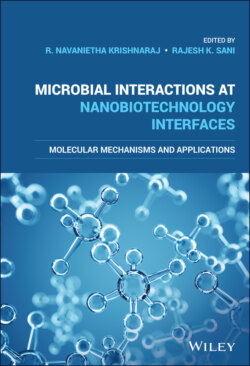Читать книгу Microbial Interactions at Nanobiotechnology Interfaces - Группа авторов - Страница 39
1.6.1.2 Acting as Good Carriers of Antibiotics
ОглавлениеAs mentioned above, NMs can also act as a carrier for various antibiotics. The delivery mechanism of NMs is different from that of other available drug delivery systems. Various NMs that have attracted attention and are currently in common use for drug delivery are polymeric NMs, metallic NMs, ceramic‐based NMs, micelles, liposomal NMs (Daeihamed et al., 2017), and carbon‐based NMs (Ranghar et al., 2014). For being an efficient antibiotics delivery system NMs possess following advantages:
1 Size: The tunable ultrasmall size of NMs makes them a suitable delivery system as they can act against intracellular bacteria. Antibiotics have poor membrane transport, which makes it difficult for them to kill intracellular and drug‐resistant microbes. On the other hand, drug‐loaded NMs can easily pass cell membranes and act. Further, NMs can also enter host cells by phagocytosis and get released inside by endocytosis (Andrade et al., 2013).
2 Protection: When a direct drug goes inside the body, the chemical present inside could deteriorate drug molecules or microbes could develop resistance against them. Also, uptake of antibiotics in bacterial cells is very slow and less. NMs‐based carriers maintain the drug potency and protect it from resistance by microbes. The uptake rate of NMs can be manipulated as needed. For example, in gastrointestinal (GI) tract, dendrimers inhibit glycoprotein‐mediated efflux of drug (Liu, Tee, & Chiu, 2015).
3 Precision and security: Side effects of antibiotics and their targeted delivery is an important concern, which is difficult to achieve with conventional drug delivery. The targeted delivery of antibiotics to the infection site minimizes systemic side effects. NM‐based drug delivery helps in delivering the drug to targeted site and reduces the risk of side effects. With this, higher dose can be applied to the site of infection directly. This targeted drug delivery can be either active or passive. In active targeting, the NM's surface is modified to selectively recognize the signals on the target infected site, whereas, in passive targeting, permeation, and retention of drug‐loaded NMs is increased at the infection site. Drugs like vancomycin that have kidney toxicity but are good for Gram‐positive infections can be delivered to the desired location by loading in mesoporous silica NMs (Qi et al., 2013). The prerequisite for effective target therapy is to target macrophages with NMs, make macrophages active, and then release the drug (Xiong et al., 2012).
4 Controllability: As mentioned above, the controlled release of any drug is crucial for its action mechanism. Conventional delivery methods failed to maintain controlled and sustained release of many drugs. This resulted in either high drug levels for short time periods or very low drug levels. Thus, repeated dosage is given, which has its own side effects. NMs' ability to slowly release the drugs at therapeutic concentration results in reduced frequency of dosing and pain. The prolonged drug release from NM‐based delivery systems provides better inhibitory effects on microbial growth (Liu, Zhang, Li, Yang, Pan, Kong, & Zhang, 2016).Further, the drug release from NMs can also be controlled by making them responsive to various stimulatory factors like temperature, pH, light, chemicals, or magnetic field (Lim, Chung, & Chung, 2018; Wu et al., 2016). Similar systems are already being explored for better controlled drug release. For example, drugs like levofloxacin are delivered using solid–lipid NMs, which prolong the retention for ocular applications (Baig et al., 2016).
5 Combination: Another important advantage of NM‐based drug delivery is its ability to deliver multiple drugs at the same time through the same channel. In many cases, the targeted site of infection has multiple microbes present, requiring the delivery of specific drugs for each type. In such cases, multiple drugs can be packed and delivered using same NMs. Also, for single‐cell type, it is difficult to develop resistance to multiple antibiotics that are delivered through same NM at the same time. Multiple action mechanisms make this kind of system more efficient.
On the other hand, two or more types of NMs can also be combined to overcome the disadvantages of a single type of NM. The much explored liposome‐based drug delivery system has a short shelf life, less stability, and low encapsulation efficacy. This system can be combined with other delivery systems like solid lipid NMs to obtain hybrid NM with improved properties. Another example of a hybrid NM delivery system are lipid–polymer NMs with better efficacy (Hadinoto, Sundaresan, & Cheow, 2013).
